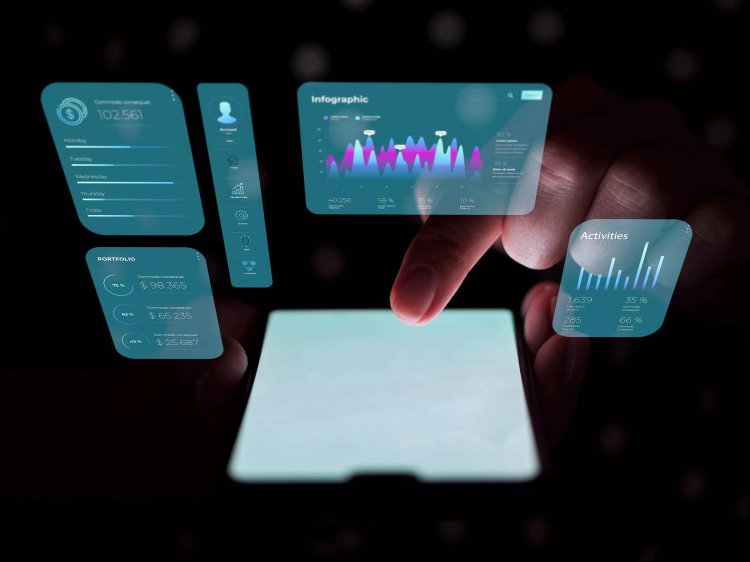AR App Development Guide
Share this Post to earn Money ( Upto ₹100 per 1000 Views )

Augmented reality isn’t just hype, it's a game-changing technology that’s already redefining industries, from retail to real estate, from education to healthcare. If you're a business eyeing AR app development or a developer eager to push learn more, you're stepping into a space with explosive potential and high user engagement.
Let me walk you through everything you need to know from concept to code to customer adoption about augmented reality application development in today’s digital-first world.
What is augmented reality app development?
Simply put, AR app development means building applications that overlay virtual content onto the real world, think 3D models, interactive animations or information layers that pop up through your smartphone, tablet or AR glasses. Unlike virtual reality, AR keeps users grounded in reality but elevates what they see and experience.
Consider Zillow 3D Home AR, which allows prospective buyers to virtually stage and explore properties; Sephora Virtual Artist, enabling users to try on makeup products using AR; and Tallaween, Ireland's first virtual theme park, offering an immersive AR experience with games and performances.
Why should businesses care about AR app development?
The digital experience is no longer a nice-to-have; it's the battleground for customer loyalty. Augmented reality app development is now a strategic move that can:
-
Reduce product return rates (especially in retail)
-
Increase buyer confidence (especially in real estate)
-
Better education and training
-
Improve patient care in healthcare
-
Gamify and humanize user experiences
Here’s the kicker: according to Statista, the AR market is expected to reach $97 billion by 2028. Early adopters will own the space and latecomers will struggle to keep up.
Core features of a high-impact AR application
The heart of every successful augmented reality mobile app development lies in thoughtful feature integration. Here are must-haves for robust performance and unforgettable user engagement:
1. 3D object recognition
Crucial for AR shopping apps is recognizing a couch and letting users swap colors or styles on the fly.
2. Real-time rendering
Users expect smooth, lifelike interactions. High-performance rendering is what separates wow from meh.
3. Gesture & voice controls
Touchless interaction is a game-changer in industries like healthcare, where hands-free functionality is vital.
4. Location-based AR
Add context to experiences. AR navigation, tourism apps, or AR-enhanced store visits all thrive on geo-positioning.
5. Multi-user support
Multi-player AR games? Collaborative design reviews? Real-time AR interactions between users are fast becoming the norm.
AR application development process: step-by-step
Whether you’re building from scratch or hiring an agency, your augmented reality app development roadmap should look like this:
1. Ideation & goal mapping
Define the purpose: Are you educating? Selling? Training? Enhancing? Align the AR experience with core business outcomes.
2. Design & UX strategy
AR UX is a different beast. Focus on:
-
Minimal UIs (AR is the interface)
-
Natural user flow
-
Real-world anchoring
3. Platform & SDK selection
Choose your tools wisely:
-
Unity with AR Foundation: Great for cross-platform.
-
ARKit: Apple-only but super powerful.
-
ARCore: Android-friendly with strong environmental tracking.
-
Vuforia: Ideal for marker-based solutions.
4. Development & integration
Blend backend data with AR visuals. Don’t forget database hooks, product APIs or e-commerce integrations where needed.
5. QA testing across devices
Don’t underestimate how lighting, surfaces and phone specs can wreck or enrich AR experiences.
6. Deployment & maintenance
Launch on app stores with solid metadata, video previews and onboarding. Post-launch, iterate fast based on analytics and user feedback.
Challenges to expect in AR app development
Let’s not sugarcoat it. AR application development has its hurdles:
-
Device limitations: Older phones may lack the sensors or power for AR.
-
UX complexity: Bad AR feels clunky or gimmicky.
-
Data privacy: You’ll likely be accessing cameras, mics, and locations. Secure this data, and be transparent.
-
Cross-platform bugs: What works perfectly on iOS might flop on Android if you don’t test comprehensively.
But overcoming these challenges? That’s what makes a great AR developer or a visionary business leader.
Best practices for scalable AR app success
-
Design for real-world interaction: Your app isn't just code, it's a lens into the physical world.
-
Keep content relevant and lightweight: Lag is a killer. Optimize your 3D assets and avoid overloading.
-
Support multiple devices: Use frameworks that abstract the hardware layer but test for edge cases.
-
Use analytics: Measure where users drop off or what features delight them.
-
Plan for maintenance: AR evolves fast, so keep your app up to date.
What’s the future of AR application development?
AR is about to go mainstream. Think:
-
5G-powered real-time multiplayer AR
AR glasses for enterprise use -
AI-integrated AR for personalization
-
WebAR meaning no downloads
The brands, educators and developers that embrace AR now? They’ll lead the next wave of digital evolution.
Final thoughts
AR isn’t just a tool it’s becoming the interface through which we view and interact with the world. AR app development is not about building gimmicks. It’s about creating meaningful, immersive and frictionless connections between users and their environment.
Whether you're a startup with an idea or an enterprise ready to transform operations, now is the time to harness the power of augmented reality application development and lead your industry into the future.
If you're ready to explore what AR can do for your business, this is your moment to start.

 pixelette01
pixelette01 













